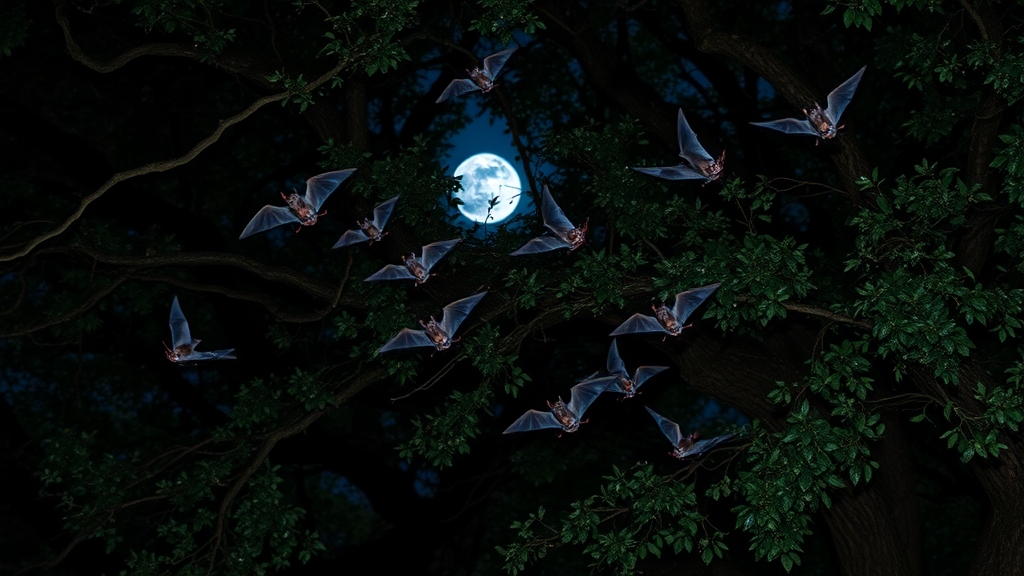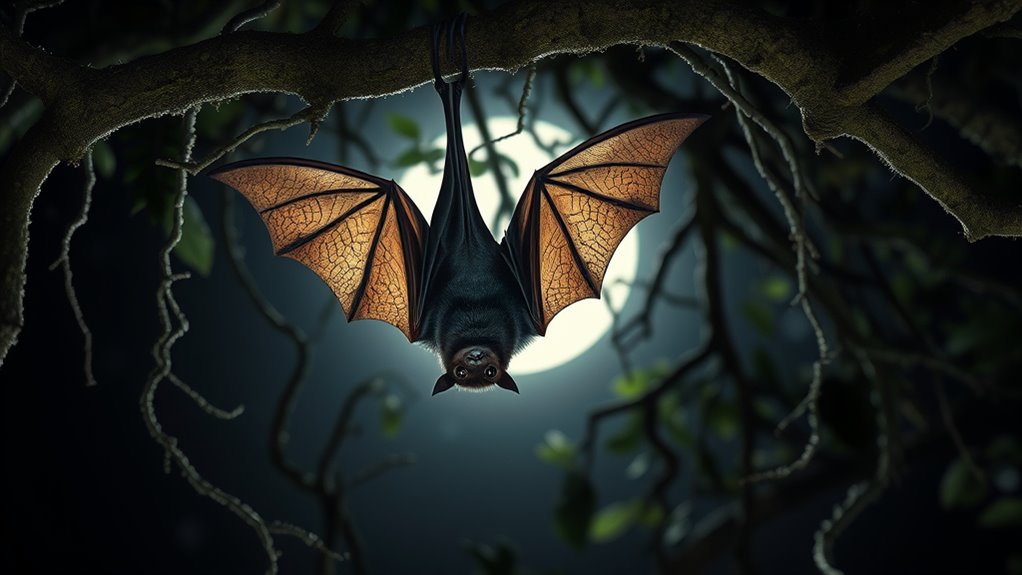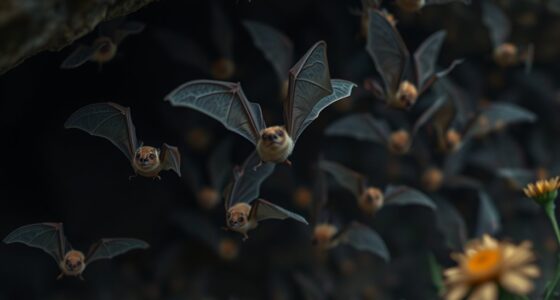At night, you might not notice bats darting through the darkness, yet they play an essential role in our ecosystems. Using impressive echolocation, they navigate, hunt insects, and avoid predators, helping control pest populations naturally. Bats also pollinate plants and disperse seeds, supporting healthy ecosystems and agriculture. Despite threats like habitat loss, conservation efforts are helping protect these incredible creatures. If you keep exploring, you’ll uncover even more about how these tiny heroes truly transform the night.
Key Takeaways
- Bats become active at night, using echolocation to navigate and hunt in complete darkness.
- Their echolocation enables detection of tiny objects and creates detailed environmental maps.
- Bats play vital roles in ecosystems as pollinators, seed dispersers, and natural insect controllers.
- They face threats like habitat loss, disease, and climate change, necessitating conservation efforts.
- Supporting bat habitats and public education helps protect these nocturnal heroes and maintain ecological balance.

Have you ever wondered what bats do when the sun goes down? As darkness falls, these incredible creatures take to the skies, engaging in activities that are essential for their survival and the health of ecosystems worldwide. Bats rely heavily on bat echolocation, a sophisticated sonar system that allows them to navigate in complete darkness and hunt with precision. By emitting high-frequency sound waves that bounce off objects and return as echoes, bats can create detailed “maps” of their surroundings. This ability not only helps them find food but also keeps them safe from obstacles and predators. Without echolocation, bats would be unable to hunt effectively or avoid dangers in their environment, making it a cornerstone of their nocturnal lifestyle. Echolocation is so effective that some species can detect objects as thin as a human hair. Interestingly, this remarkable biological adaptation has inspired technological innovations, such as sonar and robotic navigation systems. The evolution of this biological trait demonstrates how species develop remarkable skills to survive in their environments. Additionally, the development of biomimicry based on bat echolocation has led to advancements in various fields, including medical imaging and underwater exploration. However, despite their impressive adaptations, bats face numerous threats that put their populations at risk. Habitat loss, disease, and climate change have caused declines in many species. This is where bat conservation efforts become essential. By protecting roosting sites such as caves, old buildings, and forests, we guarantee bats have safe places to rest, breed, and raise their young. Conservation initiatives also focus on educating the public about the importance of bats, dispelling myths, and reducing unnecessary fears. Supporting bat conservation means supporting the health of entire ecosystems, as bats are essential pollinators, seed dispersers, and insect controllers. Their role in controlling insect populations can even reduce the need for chemical pesticides, benefiting agriculture and human health. Additionally, understanding the biological adaptations of bats can help inform conservation strategies and technological innovations inspired by their echolocation ability.
You might not realize it, but your actions can make a difference in bat conservation. Installing bat houses in your yard provides safe roosting spots, especially in areas where natural habitats are dwindling. Participating in local conservation programs or supporting organizations dedicated to bat protection can help fund research, habitat restoration, and public awareness campaigns. Avoiding the use of pesticides and preserving natural landscapes also play a significant role in maintaining healthy bat populations. As you learn more about bats and their essential roles, you’ll understand how closely tied their well-being is to the overall health of our environment. Protecting bats isn’t just about saving these fascinating creatures; it’s about safeguarding the delicate balance of life on Earth. Every effort counts, and your support can help guarantee these nocturnal heroes continue their vital work under the cover of night.
Frequently Asked Questions
Do Bats Get Rabies From Everyday Interactions?
You might wonder if bats transmit rabies through everyday interactions. The truth is, rabies transmission from bats is rare, and most bats don’t carry the virus. To protect both bats and yourself, support bat conservation efforts and avoid handling bats. Remember, rabies isn’t common in bat populations, but it’s still wise to stay cautious. Educating yourself helps you appreciate bats’ essential role while reducing unnecessary fears and promoting safety.
How Do Bats Navigate in Total Darkness?
You might think total darkness would stop bats, but their echolocation techniques make it possible. Using high-frequency sound waves they emit and listen to, bats navigate effortlessly through the night. These nocturnal adaptations allow them to avoid obstacles, find prey, and move around precisely, even in complete darkness. So, in reality, their remarkable senses give them an advantage over us in the night’s shadows.
Are All Bat Species Endangered or Just Some?
Not all bat species are endangered, but many face threats that put their populations at risk. You should know that bat conservation efforts focus on protecting species diversity, especially those most vulnerable. Some species, like the lesser long-nosed bat, are critically endangered due to habitat loss and disease, while others remain stable. Supporting habitat preservation and awareness helps make certain that more bat species thrive for generations to come.
Can Bats Live Comfortably in Urban Environments?
You might be surprised, but many bats can adapt well to urban environments. They find roosting sites in buildings, bridges, and trees, showcasing urban adaptation. While some species thrive, others may struggle due to limited natural spaces or pollution. If you want to support urban bats, consider installing bat boxes and preserving green areas, helping them find safe roosting sites and flourish in city landscapes.
What Is the Lifespan of Different Bat Species?
Think of each bat species as a unique storybook, with its own chapters of longevity. You might be surprised to learn that some bats, like the little brown bat, live up to 20 years, showcasing impressive bat longevity. Others, like larger fruit bats, can reach over 30 years. Overall, species lifespan varies widely, but most bats live longer than you’d expect, making their mysterious lives even more fascinating.
Conclusion
Now that you’ve uncovered the secret life of bats, you see they’re not just shadows in the night but essential heroes guiding nature’s dance. Like silent guardians, they keep ecosystems balanced, proving that even the smallest creatures can have the biggest impact. So next time you see a bat, remember, they’re the night’s unsung heroes, softly weaving their magic in the darkness and reminding you that wonders often hide where you least expect them.







